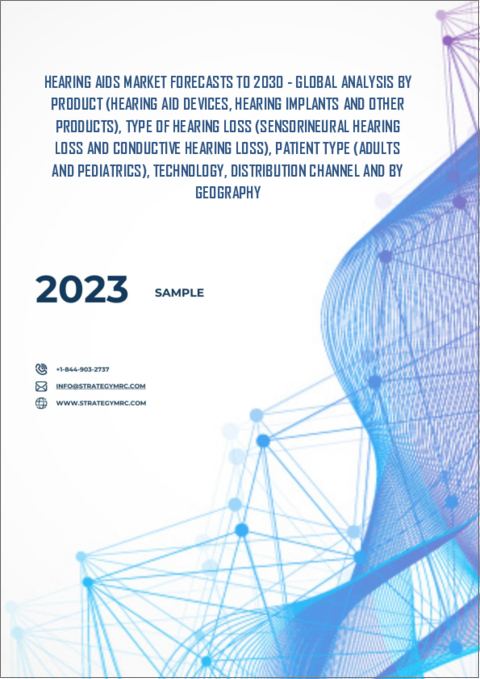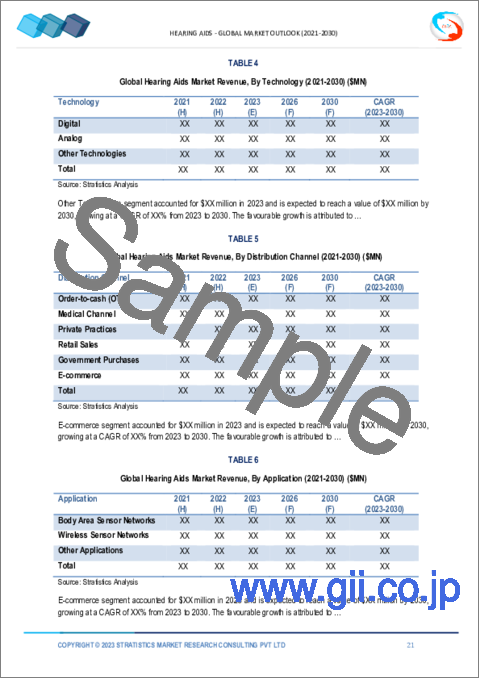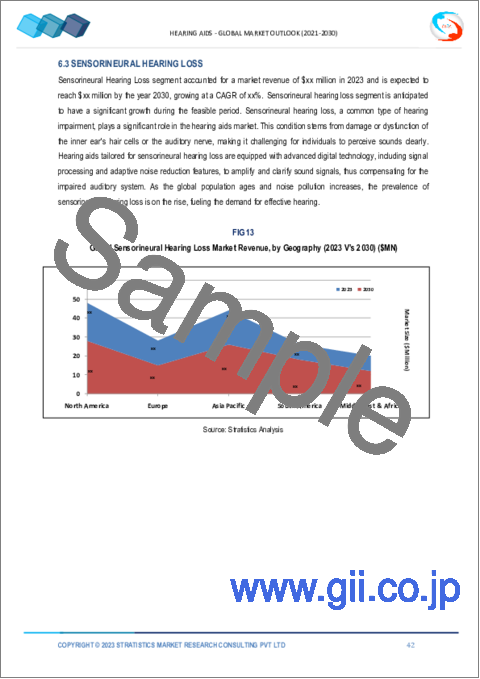|
|
市場調査レポート
商品コード
1351122
補聴器市場の2030年までの予測:セグメント別、地域別の世界分析Hearing Aids Market Forecasts to 2030 - Global Analysis By Product, Type of Hearing Loss, Patient Type, Technology, Distribution Channel and By Geography |
||||||
カスタマイズ可能
|
|||||||
| 補聴器市場の2030年までの予測:セグメント別、地域別の世界分析 |
|
出版日: 2023年09月01日
発行: Stratistics Market Research Consulting
ページ情報: 英文 175+ Pages
納期: 2~3営業日
|
- 全表示
- 概要
- 図表
- 目次
Stratistics MRCによると、補聴器の世界市場は2023年に88億1,000万米ドルを占め、予測期間中のCAGRは8.4%で成長し、2030年には155億米ドルに達すると予測されています。
補聴器は、音を増幅することで難聴者の聴力を改善する医療機器です。補聴器は、マイク、アンプ、スピーカーの3つの部品から成るシステムを利用し、音を増幅することで機能します。これらの部品が進歩するにつれて、その効果は向上し、より持続可能なものとなります。補聴器の目的は、聞こえにくい音を増幅することです。補聴器は正常な聴力を回復させるものではありませんが、聴力を向上させるために最善を尽くします。
世界保健機関(WHO)によると、衰弱性難聴を抱える人の数は、2050年までに9億人を超えると言われています。
環境音の改善
高度な環境音改善機能を備えた補聴器は、機械学習アルゴリズムを使用して、ユーザーの好みや独自の聴覚環境に継続的に適応します。音の分析を通じて、これらのアルゴリズムは不要な雑音を認識・除去する一方で、音声のような必要な音を優先させることができます。さらに、補聴器はユーザーの嗜好や聴力に基づいて徐々にパーソナライズされたサウンドプロファイルを開発するため、ユーザーは静かな室内から賑やかな公共スペースまで、様々な環境でより快適で自然な聴覚体験をすることができます。
補聴器の高価格
高品質な補聴器の価格は、依然として市場の大きな障壁となっています。補聴器の高価格は、高度な技術、研究開発努力の結果です。その結果、多くの人々、特に定収入のある人や保険に加入していない人は、補聴器を購入することができないです。高額な費用のために、難聴に必要な治療を受けることを断念し、対策を遅らせ、症状を悪化させる可能性もあります。
技術革新
補聴器業界は技術の進歩から大きな恩恵を受けています。人工知能(AI)、機械学習アルゴリズム、デジタル信号処理などは、これらの技術革新の一部です。補聴器は小型化によってより小さく、より目立たないようになり、騒音低減技術や音声強調技術によって騒音下での補聴器の性能は大幅に向上しました。さらに、補聴器は、スマートフォンやその他の機器とのシームレスな相互作用を可能にするBluetooth接続の統合により、技術に精通したユーザーにとってより適応性が高く魅力的なものとなっています。
個人用音響増幅器製品との競合
補聴器市場は、市販の個人用音響増幅器(PSAP)の人気上昇によって深刻な脅威にさらされています。さらに、これらの製品は従来の補聴器よりも安価であることが多く、軽度から中等度の難聴者に訴求する可能性があるため、専門的な聴覚医療を受けることを躊躇させ、補聴器の販売に悪影響を及ぼす可能性があります。
COVID-19の影響:
COVID-19の流行は補聴器業界に様々な影響を与えました。オンライン相談やフィッティングのための遠隔医療サービスの利用が増加した結果、補聴器への関心が高まり、また個人の衛生や健康に対する意識が高まっています。さらに、パンデミックは、聴覚の健康が社会的孤立やコミュニケーションの困難さの中でいかに重要であるかを明らかにしました。
予測期間中、補聴器分野が最大となる見込み
予測期間中、補聴器分野が最大の市場シェアを占めると予想されます。難聴を管理する最も一般的な方法は、これらの非侵襲的な機器です。補聴器は、様々なレベルの聴覚障害に対応し、幅広い流行や技術的進歩に対応しています。さらに、補聴器はその適応性、使いやすさ、アクセスのしやすさから、難聴治療の第一選択肢となっています。継続的な技術の進歩、聴覚の健康の重要性に対する意識の高まり、世界人口の高齢化などの結果、補聴器市場は今後も拡大すると予想されます。
予測期間中のCAGRはデジタルセグメントが最も高い見込み
デジタル分野は予測期間中に有利な成長が見込まれます。ワイヤレス接続、スマートフォンアプリ、遠隔医療機能といった機能の搭載だけでなく、より良いユーザーエクスペリエンスへの要望が、補聴器におけるデジタル技術の急速な採用を後押ししています。より幅広い聴覚障害に対応する能力と、シームレスで個別化された聴覚ソリューションに対する消費者の期待の変化により、デジタル補聴器は着実に市場シェアを伸ばしています。
最大のシェアを占める地域:
予測期間中、欧州地域が最大の市場シェアを占めると予想されます。欧州市場の特徴は、人口の高齢化が著しく、ヘルスケアに注力し、聴覚の健康問題に対する意識が高いことです。欧州の多くの国では、補聴器の提供を含む聴覚ケアソリューションへのアクセスを容易にするヘルスケアシステムが開発されています。さらに、欧州では厳しい規則と品質要求があり、補聴器が厳しい性能と安全基準を遵守していることが保証されています。これらの要因が重なり、高齢化社会の中で最先端の聴覚ソリューションに対する需要が高まっているため、欧州は引き続き大きな市場シェアを占めています。
CAGRが最も高い地域:
人口の増加と高齢化、可処分所得の増加、聴覚の健康に対する意識の高まり、ヘルスケアインフラの拡大により、アジア太平洋地域のCAGRが最も高いと推定されます。中国やインドなどの国々では、騒音公害や産業騒音への暴露、急速な都市化、工業化によって難聴の有病率が増加しています。その結果、アジア太平洋地域の補聴器需要は大幅に増加しており、消費者が最先端の聴覚ソリューションを求める中、この動向は今後も続くと予想されます。
無料のカスタマイズサービス:
本レポートをご購読のお客様には、以下の無料カスタマイズオプションのいずれかをご提供いたします:
- 企業プロファイル
- 追加市場プレーヤーの包括的プロファイリング(3社まで)
- 主要企業のSWOT分析(3社まで)
- 地域セグメンテーション
- 顧客の関心に応じた主要国の市場推計・予測・CAGR(注:フィージビリティチェックによる)
- 競合ベンチマーキング
- 製品ポートフォリオ、地理的プレゼンス、戦略的提携に基づく主要企業のベンチマーキング
目次
第1章 エグゼクティブサマリー
第2章 序文
- 概要
- ステークホルダー
- 調査範囲
- 調査手法
- データマイニング
- データ分析
- データ検証
- 調査アプローチ
- 調査ソース
- 1次調査ソース
- 2次調査ソース
- 前提条件
第3章 市場動向分析
- 促進要因
- 抑制要因
- 機会
- 脅威
- 製品分析
- 技術分析
- 用途分析
- 新興市場
- 新型コロナウイルス感染症(COVID-19)の影響
第4章 ポーターのファイブフォース分析
- 供給企業の交渉力
- 買い手の交渉力
- 代替品の脅威
- 新規参入業者の脅威
- 競争企業間の敵対関係
第5章 世界の補聴器市場:製品別
- 補聴器
- 耳かけ型補聴器(RITE)
- 耳かけ型補聴器(BTE )
- 耳あな型補聴器
- 耳あな型補聴器(ITE)
- 聴覚インプラント
- 人工内耳
- 骨固定システム
- その他の製品
第6章 世界の補聴器市場:難聴タイプ別
- 感音性難聴
- 伝音性難聴
第7章 世界の補聴器市場:患者タイプ別
- 大人
- 小児
第8章 世界の補聴器市場:技術別
- デジタル
- アナログ
- その他の技術
第9章 世界の補聴器市場:流通チャネル別
- Order to Cash(O2C)
- 医療チャンネル
- 個人診療所
- 小売販売
- 会社所有
- 独立小売店
- 政府による購入
- eコマース
第10章 世界の補聴器市場:用途別
- 身体エリアセンサーネットワーク
- ワイヤレスセンサーネットワーク
- その他の用途
第11章 世界の補聴器市場:地域別
- 北米
- 米国
- カナダ
- メキシコ
- 欧州
- ドイツ
- 英国
- イタリア
- フランス
- スペイン
- その他欧州
- アジア太平洋地域
- 日本
- 中国
- インド
- オーストラリア
- ニュージーランド
- 韓国
- その他アジア太平洋地域
- 南米
- アルゼンチン
- ブラジル
- チリ
- その他南米
- 中東とアフリカ
- サウジアラビア
- アラブ首長国連邦
- カタール
- 南アフリカ
- その他中東とアフリカ
第12章 主な発展
- 契約、パートナーシップ、コラボレーション、合弁事業
- 買収と合併
- 新製品の発売
- 事業拡大
- その他の主要戦略
第13章 企業プロファイル
- RION Co., Ltd.
- Earlens Corporation
- IN4 Technology Corporation
- Sonova Group
- Elkon Pvt. Ltd.
- Horentek Hearing Diagnostics
- Medtronic PLC
- Audina Hearing Instruments, Inc.
- Nurotron Biotechnology Co., Ltd.
- Foshan Vohom Technology Co., Ltd
- Starkey Laboratories, Inc.
- Eargo, Inc.
- SeboTek Hearing Systems, LLC
- Microson
- Cochlear Ltd.
- Siemens AG
- Amplifon SpA
- Lucid Hearing
- Arphi Electronics Private Limited
List of Tables
- Table 1 Global Hearing Aids Market Outlook, By Region (2021-2030) ($MN)
- Table 2 Global Hearing Aids Market Outlook, By Product (2021-2030) ($MN)
- Table 3 Global Hearing Aids Market Outlook, By Hearing Aid Devices (2021-2030) ($MN)
- Table 4 Global Hearing Aids Market Outlook, By Receiver-in-the-ear Hearing Aids (2021-2030) ($MN)
- Table 5 Global Hearing Aids Market Outlook, By Behind-the-ear Hearing Aids (2021-2030) ($MN)
- Table 6 Global Hearing Aids Market Outlook, By Canal Hearing Aids (2021-2030) ($MN)
- Table 7 Global Hearing Aids Market Outlook, By In-the-ear Hearing Aids (2021-2030) ($MN)
- Table 8 Global Hearing Aids Market Outlook, By Hearing Implants (2021-2030) ($MN)
- Table 9 Global Hearing Aids Market Outlook, By Cochlear Implants (2021-2030) ($MN)
- Table 10 Global Hearing Aids Market Outlook, By Bone-anchored Systems (2021-2030) ($MN)
- Table 11 Global Hearing Aids Market Outlook, By Other Products (2021-2030) ($MN)
- Table 12 Global Hearing Aids Market Outlook, By Type of Hearing Loss (2021-2030) ($MN)
- Table 13 Global Hearing Aids Market Outlook, By Sensorineural Hearing Loss (2021-2030) ($MN)
- Table 14 Global Hearing Aids Market Outlook, By Conductive Hearing Loss (2021-2030) ($MN)
- Table 15 Global Hearing Aids Market Outlook, By Patient Type (2021-2030) ($MN)
- Table 16 Global Hearing Aids Market Outlook, By Adults (2021-2030) ($MN)
- Table 17 Global Hearing Aids Market Outlook, By Pediatrics (2021-2030) ($MN)
- Table 18 Global Hearing Aids Market Outlook, By Technology (2021-2030) ($MN)
- Table 19 Global Hearing Aids Market Outlook, By Digital (2021-2030) ($MN)
- Table 20 Global Hearing Aids Market Outlook, By Analog (2021-2030) ($MN)
- Table 21 Global Hearing Aids Market Outlook, By Other Technologies (2021-2030) ($MN)
- Table 22 Global Hearing Aids Market Outlook, By Distribution Channel (2021-2030) ($MN)
- Table 23 Global Hearing Aids Market Outlook, By Order-to-cash (OTC) (2021-2030) ($MN)
- Table 24 Global Hearing Aids Market Outlook, By Medical Channel (2021-2030) ($MN)
- Table 25 Global Hearing Aids Market Outlook, By Private Practices (2021-2030) ($MN)
- Table 26 Global Hearing Aids Market Outlook, By Retail Sales (2021-2030) ($MN)
- Table 27 Global Hearing Aids Market Outlook, By Company Owned (2021-2030) ($MN)
- Table 28 Global Hearing Aids Market Outlook, By Independent Retail (2021-2030) ($MN)
- Table 29 Global Hearing Aids Market Outlook, By Government Purchases (2021-2030) ($MN)
- Table 30 Global Hearing Aids Market Outlook, By E-commerce (2021-2030) ($MN)
- Table 31 Global Hearing Aids Market Outlook, By Application (2021-2030) ($MN)
- Table 32 Global Hearing Aids Market Outlook, By Body Area Sensor Networks (2021-2030) ($MN)
- Table 33 Global Hearing Aids Market Outlook, By Wireless Sensor Networks (2021-2030) ($MN)
- Table 34 Global Hearing Aids Market Outlook, By Other Applications (2021-2030) ($MN)
Note: Tables for North America, Europe, APAC, South America, and Middle East & Africa Regions are also represented in the same manner as above.
According to Stratistics MRC, the Global Hearing Aids Market is accounted for $8.81 billion in 2023 and is expected to reach $15.50 billion by 2030 growing at a CAGR of 8.4% during the forecast period. A hearing aid is a medical device that improves hearing for those who have hearing loss by amplifying sound. Utilizing a three-part system made up of a microphone, amplifier, and speaker, they work by amplifying sound. As these components advance, their effectiveness improves, and they become more sustainable. The purpose of a hearing aid device or solution is to amplify sounds that a person has trouble hearing. Although these devices don't restore normal hearing, they do their best to enhance it.
According to the World Health Organization (WHO), the number of people living with debilitating hearing loss will exceed 900 million by 2050.
Market Dynamics:
Driver:
Improvement of environmental sound
Hearing aids with advanced environmental sound enhancement use machine learning algorithms to continuously adapt to the preferences and unique auditory environments of the user. Through the analysis of sounds, these algorithms are able to recognize and eliminate unwanted noise while giving desired sounds, like speech, priority. Additionally, hearing aid users experience a more comfortable and natural auditory experience in a variety of settings, from quiet rooms to busy public spaces, as the hearing aids gradually develop personalized sound profiles based on user preferences and hearing capabilities.
Restraint:
High price of hearing aids
The price of high-quality hearing aids continues to be a major market barrier. The high cost of these devices is a result of sophisticated technology, research, and development efforts. As a result, many people, especially those with fixed incomes or no insurance, might find hearing aids out of their price range. Due to the high cost, some potential users may decide against receiving the necessary treatment for their hearing loss, delaying action and possibly making their condition worse.
Opportunity:
Technological innovations
The hearing aid industry has greatly benefited from technological advancements. Artificial intelligence (AI), machine learning algorithms, and digital signal processing are some of these innovations. Smaller and more covert devices have been made possible by miniaturization, and the performance of hearing aids in noisy environments has been greatly enhanced by noise reduction and speech enhancement technologies. Moreover, hearing aids are also more adaptable and appealing to tech-savvy users thanks to their Bluetooth connectivity integration, which enables seamless interaction with smartphones and other devices.
Threat:
Competition from personal sound amplification products
The market for hearing aids is seriously threatened by the rising popularity of over-the-counter personal sound amplification products (PSAPs). Moreover, these products, which are frequently less expensive than conventional hearing aids, might appeal to people with mild to moderate hearing loss, deterring them from seeking professional hearing healthcare and possibly having an adverse effect on hearing aid sales.
COVID-19 Impact:
The COVID-19 pandemic had a wide range of effects on the hearing aid industry. There was growing interest in hearing aids as a result of increased use of telehealth services for online consultations and fittings, as well as increased awareness of personal hygiene and health. Furthermore, the pandemic also made clear how crucial hearing health is in the context of social isolation and communication difficulties.
The hearing aid devices segment is expected to be the largest during the forecast period
During the forecast period, the hearing aid devices segment is anticipated to have the largest market share. The most popular method of managing hearing loss is with these non-invasive devices. They accommodate varying levels of hearing impairment and a wide range of fashions and technological advancements. Moreover, hearing aid devices are the first option for treating hearing loss because of their adaptability, usability, and accessibility. As a result of ongoing technological advancements, raised awareness of the importance of hearing health, and an aging world population, the market for these devices is expected to continue to expand.
The Digital segment is expected to have the highest CAGR during the forecast period
The digital segment is expected to have lucrative growth during the forecast period. The desire for better user experiences as well as the incorporation of features like wireless connectivity, smartphone apps, and telehealth capabilities driving the rapid adoption of digital technology in hearing aids. Due to their capacity to address a wider range of hearing impairments and changing consumer expectations for seamless and individualized auditory solutions, digital hearing aids are steadily increasing their market share.
Region with largest share:
The European region is expected to have the largest market share in the forecast period. The European market is characterized by a significant aging population, a focus on healthcare, and a high awareness of hearing health issues. Many European nations have developed healthcare systems that facilitate access to hearing care solutions, including the provision of hearing aids. Furthermore, strict rules and quality requirements in Europe guarantee that hearing aid devices adhere to strict performance and safety standards. Because of a combination of these factors and a rising demand for cutting-edge hearing solutions among its aging population, Europe continues to hold a sizable market share.
Region with highest CAGR:
Due to a large and aging population, rising disposable incomes, increased awareness of hearing health, and an expanding healthcare infrastructure, the Asia-Pacific region is estimated to experience the highest CAGR. Noise pollution and exposure to industrial noise, rapid urbanization, and industrialization in nations like China and India have increased the prevalence of hearing loss. As a result, the demand for hearing aids in the Asia-Pacific region is increasing significantly, and this trend is anticipated to continue as consumers look for cutting-edge hearing solutions.
Key players in the market:
Some of the key players in Hearing Aids market include: RION Co., Ltd., Earlens Corporation, IN4 Technology Corporation, Sonova Group, Elkon Pvt. Ltd., Horentek Hearing Diagnostics, Medtronic PLC, Audina Hearing Instruments, Inc., Nurotron Biotechnology Co., Ltd., Foshan Vohom Technology Co., Ltd, Starkey Laboratories, Inc., Eargo, Inc., SeboTek Hearing Systems, LLC, Microson, Cochlear Ltd., Siemens AG, Amplifon SpA, Lucid Hearing and Arphi Electronics Private Limited.
Key Developments:
In February 2023, Lucid Hearing expanded its partnerships with several retail partners to increase access to hearing devices by making it available over-the-counter to the patient population.
In January 2023, Sonova launched Conversation Clear Plus earbuds to establish a new product category in early entry hearing solutions.
In July 2022, Rion Co., Ltd. entered into an agreement to acquire 92.39% stake in Norsonic AS from Asisa As, Norsonic-Tippkemper Gmbh, Janix Ikt As, Jacon A/S and others for approximately NOK 120 million.
Products Covered:
- Hearing Aid Devices
- Hearing Implants
- Other Products
Type of Hearing Losses Covered:
- Sensorineural Hearing Loss
- Conductive Hearing Loss
Patient Types Covered:
- Adults
- Pediatrics
Technologies Covered:
- Digital
- Analog
- Other Technologies
Distribution Channels Covered:
- Order-to-cash (OTC)
- Medical Channel
- Private Practices
- Retail Sales
- Government Purchases
- E-commerce
Applications Covered:
- Body Area Sensor Networks
- Wireless Sensor Networks
- Other Applications
Regions Covered:
- North America
- US
- Canada
- Mexico
- Europe
- Germany
- UK
- Italy
- France
- Spain
- Rest of Europe
- Asia Pacific
- Japan
- China
- India
- Australia
- New Zealand
- South Korea
- Rest of Asia Pacific
- South America
- Argentina
- Brazil
- Chile
- Rest of South America
- Middle East & Africa
- Saudi Arabia
- UAE
- Qatar
- South Africa
- Rest of Middle East & Africa
What our report offers:
- Market share assessments for the regional and country-level segments
- Strategic recommendations for the new entrants
- Covers Market data for the years 2021, 2022, 2023, 2026, and 2030
- Market Trends (Drivers, Constraints, Opportunities, Threats, Challenges, Investment Opportunities, and recommendations)
- Strategic recommendations in key business segments based on the market estimations
- Competitive landscaping mapping the key common trends
- Company profiling with detailed strategies, financials, and recent developments
- Supply chain trends mapping the latest technological advancements
Free Customization Offerings:
All the customers of this report will be entitled to receive one of the following free customization options:
- Company Profiling
- Comprehensive profiling of additional market players (up to 3)
- SWOT Analysis of key players (up to 3)
- Regional Segmentation
- Market estimations, Forecasts and CAGR of any prominent country as per the client's interest (Note: Depends on feasibility check)
- Competitive Benchmarking
- Benchmarking of key players based on product portfolio, geographical presence, and strategic alliances
Table of Contents
1 Executive Summary
2 Preface
- 2.1 Abstract
- 2.2 Stake Holders
- 2.3 Research Scope
- 2.4 Research Methodology
- 2.4.1 Data Mining
- 2.4.2 Data Analysis
- 2.4.3 Data Validation
- 2.4.4 Research Approach
- 2.5 Research Sources
- 2.5.1 Primary Research Sources
- 2.5.2 Secondary Research Sources
- 2.5.3 Assumptions
3 Market Trend Analysis
- 3.1 Introduction
- 3.2 Drivers
- 3.3 Restraints
- 3.4 Opportunities
- 3.5 Threats
- 3.6 Product Analysis
- 3.7 Technology Analysis
- 3.8 Application Analysis
- 3.9 Emerging Markets
- 3.10 Impact of Covid-19
4 Porters Five Force Analysis
- 4.1 Bargaining power of suppliers
- 4.2 Bargaining power of buyers
- 4.3 Threat of substitutes
- 4.4 Threat of new entrants
- 4.5 Competitive rivalry
5 Global Hearing Aids Market, By Product
- 5.1 Introduction
- 5.2 Hearing Aid Devices
- 5.2.1 Receiver-in-the-ear Hearing Aids
- 5.2.2 Behind-the-ear Hearing Aids
- 5.2.3 Canal Hearing Aids
- 5.2.4 In-the-ear Hearing Aids
- 5.3 Hearing Implants
- 5.3.1 Cochlear Implants
- 5.3.2 Bone-anchored Systems
- 5.4 Other Products
6 Global Hearing Aids Market, By Type of Hearing Loss
- 6.1 Introduction
- 6.2 Sensorineural Hearing Loss
- 6.3 Conductive Hearing Loss
7 Global Hearing Aids Market, By Patient Type
- 7.1 Introduction
- 7.2 Adults
- 7.3 Pediatrics
8 Global Hearing Aids Market, By Technology
- 8.1 Introduction
- 8.2 Digital
- 8.3 Analog
- 8.4 Other Technologies
9 Global Hearing Aids Market, By Distribution Channel
- 9.1 Introduction
- 9.2 Order-to-cash (OTC)
- 9.3 Medical Channel
- 9.4 Private Practices
- 9.5 Retail Sales
- 9.5.1 Company Owned
- 9.5.2 Independent Retail
- 9.6 Government Purchases
- 9.7 E-commerce
10 Global Hearing Aids Market, By Application
- 10.1 Introduction
- 10.2 Body Area Sensor Networks
- 10.3 Wireless Sensor Networks
- 10.4 Other Applications
11 Global Hearing Aids Market, By Geography
- 11.1 Introduction
- 11.2 North America
- 11.2.1 US
- 11.2.2 Canada
- 11.2.3 Mexico
- 11.3 Europe
- 11.3.1 Germany
- 11.3.2 UK
- 11.3.3 Italy
- 11.3.4 France
- 11.3.5 Spain
- 11.3.6 Rest of Europe
- 11.4 Asia Pacific
- 11.4.1 Japan
- 11.4.2 China
- 11.4.3 India
- 11.4.4 Australia
- 11.4.5 New Zealand
- 11.4.6 South Korea
- 11.4.7 Rest of Asia Pacific
- 11.5 South America
- 11.5.1 Argentina
- 11.5.2 Brazil
- 11.5.3 Chile
- 11.5.4 Rest of South America
- 11.6 Middle East & Africa
- 11.6.1 Saudi Arabia
- 11.6.2 UAE
- 11.6.3 Qatar
- 11.6.4 South Africa
- 11.6.5 Rest of Middle East & Africa
12 Key Developments
- 12.1 Agreements, Partnerships, Collaborations and Joint Ventures
- 12.2 Acquisitions & Mergers
- 12.3 New Product Launch
- 12.4 Expansions
- 12.5 Other Key Strategies
13 Company Profiling
- 13.1 RION Co., Ltd.
- 13.2 Earlens Corporation
- 13.3 IN4 Technology Corporation
- 13.4 Sonova Group
- 13.5 Elkon Pvt. Ltd.
- 13.6 Horentek Hearing Diagnostics
- 13.7 Medtronic PLC
- 13.8 Audina Hearing Instruments, Inc.
- 13.9 Nurotron Biotechnology Co., Ltd.
- 13.10 Foshan Vohom Technology Co., Ltd
- 13.11 Starkey Laboratories, Inc.
- 13.12 Eargo, Inc.
- 13.13 SeboTek Hearing Systems, LLC
- 13.14 Microson
- 13.15 Cochlear Ltd.
- 13.16 Siemens AG
- 13.17 Amplifon SpA
- 13.18 Lucid Hearing
- 13.19 Arphi Electronics Private Limited






